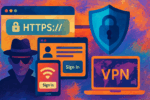1. How HTTPS Works (Broadly)
HTTPS (HyperText Transport Protocol Secure) uses TLS (Transport Layer Security) encryption to secure communication between your browser and the website.
It encrypts:
- The content of web pages (what you send/receive)
- Form data, passwords, account info, etc.
It does not encrypt:
- The domain name you’re visiting (e.g. bank.com) – this can leak via DNS or SNI.
- When you connected and how much data was exchanged (traffic patterns).
🧠 Takeaway: HTTPS protects content, but not metadata. It prevents eavesdropping and tampering in transit, but websites still know who you are if you log in.
2. Risks of Captive Portals (e.g. Hotels, Airports, Public Wi-Fi)
Captive portals intercept your initial web traffic, redirecting it to a login or terms-of-use page.
Often break HTTPS by causing certificate errors — users might wrongly click through, exposing themselves to spoofed sites.
In hostile environments (e.g., Russia, China), a captive portal may:
Act as a malicious proxy, intercepting, modifying, or logging your traffic even after login.
Attempt phishing or man-in-the-middle attacks.
Block or fingerprint VPN connections.
🧠 Takeaway: Treat captive portals as potentially untrusted and dangerous. Never ignore certificate warnings.
3. Usefulness of VPNs — With Caveats
✅ Pros:
- Encrypts all traffic, not just web browsing — including app traffic and DNS queries.
- Shields activity from local networks (hotels, cafés) and your ISP.
- Hides your IP address from websites; helps bypass geo-blocking and censorship.
⚠️ Limitations:
- The VPN can see your unencrypted traffic (i.e., it replaces your ISP — you must trust the VPN provider).
- You still need to connect to the VPN after the captive portal login.
- May not work if blocked or throttled by the network.
- Can give a false sense of security — VPNs don’t protect against phishing, compromised websites, or device malware.
👵 Non-tech-savvy users may:
- Struggle to configure or verify VPN safety.
- Not recognize when it’s disconnected.
- Click through security warnings without understanding the risk.
🧠 Takeaway: VPNs are very useful — especially on public networks — but must be used correctly and with realistic expectations. They do not make you “invisible” or “bulletproof.”
Final Advice (Practical and Secure)
- Using hotel Wi-Fi: Connect to a basic HTTP site (e.g. http://neverssl.com) to trigger the portal, then connect VPN
- Seeing a certificate warning: Stop immediately — do not proceed
- General browsing: Prefer HTTPS-only mode in your browser
- Security-conscious travel: Use VPN + updated devices + browser isolation (separate profile for travel)
🔐 Isolated Browsing: Private Windows, Profiles, and VPNs
When used thoughtfully, combining private (incognito) windows, separate browser profiles, and a VPN can significantly enhance online privacy and limit tracking.
🕶️ Private (Incognito) Mode
Private browsing windows:
- Do not save browsing history, form data, cookies, or site data after the window is closed.
- Start with a clean session, avoiding use of existing cookies or logged-in accounts.
- Are ideal for:
- One-time logins (e.g., checking a bank account)
- Shared computers
- Preventing auto-fill of sensitive data
⚠️ However, private mode does not:
- Hide your IP address
- Block trackers or ads during the session
- Prevent browser fingerprinting
- Stop websites from tracking you if you log in
🧭 Separate Browser Profiles
Creating a separate browser profile:
- Provides persistent isolation between sets of activity (e.g., work, personal, testing).
- Each profile has its own:
- Cookies and logins
- Saved passwords and history
- Extensions and settings
Use cases include:
- Keeping personal and work accounts separate
- Testing websites without shared session data
- Containing high-risk activity (e.g., unfamiliar links)
🔐 Combined with a VPN: Stronger Protection
Adding a VPN to private windows and isolated profiles further enhances protection by:
- Encrypting all traffic, shielding it from local networks and ISPs
- Hiding your IP address, preventing location tracking and fingerprinting based on IP
- Securing app traffic beyond the browser
✅ Summary of Benefits
| Feature | Benefit |
|---|---|
| Private Window | Leaves no local trace, avoids cookie reuse |
| Separate Profile | Persistent isolation between browsing contexts |
| VPN | Network-level encryption and IP masking |
🧠 Combined, these tools offer a layered defense:
- Local privacy from others using the same computer
- Reduced cross-site tracking
- Protection from untrusted or hostile networks (e.g. hotel Wi-Fi)
- Minimized risk of leaking identity or login sessions across contexts
